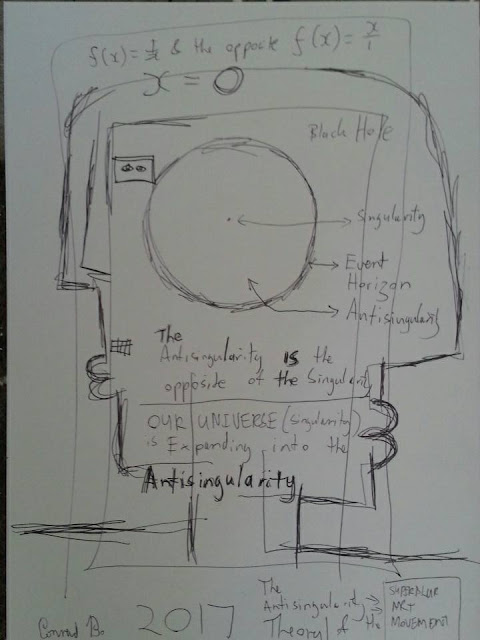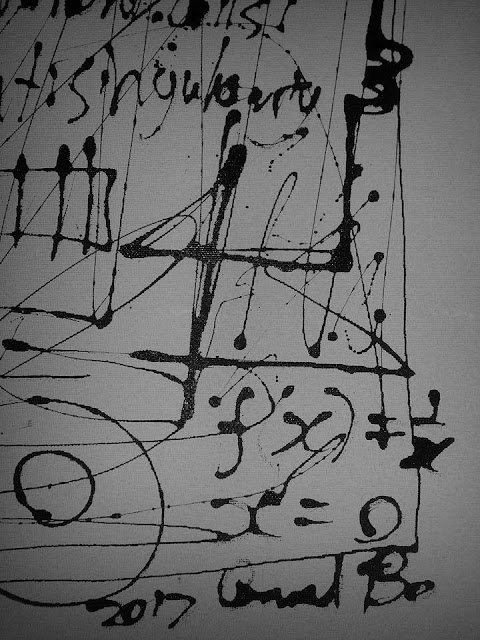As I try to explain the Anti Singularity Theory, it is important to look at the Theory of Everything and also String Theory.
In the Anti Singularity theory I propose that the space between a Singularity of a Black Hole and the Event Horizon is called the Anti Singularity (Antisingularity). In the Anti Singularity (Antisingularity) the density is zero and the volume is infinite (compared the the Singularity)
The theory of everything, also known as the ultimate theory, is a hypothetical framework in physics that seeks to explain all the fundamental forces and particles in the universe within a single, cohesive and mathematically consistent framework. It is often considered to be the holy grail of physics, as it would provide a complete and unified understanding of the nature of the universe.
The search for a theory of everything has been a long-standing goal of physicists, and it has been pursued by many of the greatest minds in the field. The idea is to find a set of equations or principles that can describe all of the phenomena in the universe, from the smallest subatomic particles to the largest structures in the cosmos. This would include the fundamental forces of nature, such as gravity, electromagnetism, the strong nuclear force, and the weak nuclear force, as well as the particles that mediate these forces, such as quarks, leptons, and gauge bosons.
One of the main challenges in developing a theory of everything is that the existing theories of physics are incompatible with each other. For example, Einstein's theory of general relativity, which describes the force of gravity, cannot be reconciled with quantum mechanics, which describes the behavior of subatomic particles. This has led many physicists to seek out new theories that can unify these seemingly disparate fields.
One of the most promising avenues for developing a theory of everything is string theory, which posits that all particles in the universe are actually tiny, vibrating strings. According to this theory, the different particles and forces in the universe arise from the way that these strings vibrate and interact with each other. While string theory has yet to be proven experimentally, it is considered by many to be the leading candidate for a theory of everything.
Another approach to developing a theory of everything is through the study of quantum gravity. This field seeks to unify general relativity and quantum mechanics by describing the behavior of gravity in terms of the particles that mediate the strong and weak nuclear forces. While quantum gravity has yet to produce a definitive theory of everything, it has led to some important insights into the nature of the universe.
Despite the many challenges that remain in developing a theory of everything, there is a growing consensus among physicists that such a theory is possible. As our understanding of the universe continues to evolve, and new technologies and experimental techniques become available, we may one day be able to unlock the secrets of the universe and develop a theory of everything that can explain the nature of the cosmos in a way that is both elegant and comprehensive.
In conclusion, the theory of everything is a long-standing goal of physics that seeks to explain all of the fundamental forces and particles in the universe within a single, cohesive framework. While there are many challenges that remain in developing such a theory, there is a growing sense among physicists that it is possible. Whether through string theory, quantum gravity, or some other approach, the pursuit of a theory of everything is one of the most exciting and important endeavors in modern science.
String theory is one of the most promising avenues for developing a theory of everything. It is a theoretical framework that seeks to describe all particles and forces in the universe as tiny, vibrating strings, rather than as point-like particles. According to this theory, the various particles and forces in the universe arise from the different ways that these strings vibrate and interact with each other.
One of the key insights of string theory is that it offers a way to reconcile the apparent incompatibility between general relativity, which describes gravity, and quantum mechanics, which describes the behavior of subatomic particles. In string theory, gravity emerges from the geometry of space-time, rather than being a fundamental force. This means that it can be described in the same way as other forces, such as electromagnetism and the strong and weak nuclear forces, which are already described by quantum mechanics.
Another important feature of string theory is that it requires the existence of additional dimensions beyond the familiar three dimensions of space and one dimension of time. In fact, string theory requires the existence of at least ten dimensions, most of which are "curled up" or "compactified" into tiny, unobservable spaces. These extra dimensions provide a way for string theory to unify the fundamental forces of nature, by allowing them to interact in ways that are not possible in our four-dimensional world.
Despite its promise, string theory remains a highly speculative and controversial area of research. One of the main criticisms of the theory is that it has yet to produce any experimental predictions that can be tested. This is partly because the energies required to observe the effects of strings are currently beyond the reach of experimental physics. Nevertheless, many physicists believe that string theory represents the best hope for developing a theory of everything, and that it will continue to be a major focus of research in the years to come.
String theory is a theoretical framework that describes the universe in terms of tiny, vibrating strings. Unlike traditional particle physics, where particles are considered to be point-like, strings are one-dimensional objects that can vibrate in different ways. The vibrations of the strings determine the properties of the particles that they represent, such as their mass, charge, and spin.
The equations that describe string theory are highly complex and involve advanced mathematical concepts such as differential geometry, topology, and algebraic geometry. In fact, the full equations of string theory are not yet known, and much of the work in the field involves developing approximations and techniques for solving them.
Nevertheless, there are several key equations in string theory that are currently known to science. One of the most fundamental is the equation for the energy of a string:
E = (hc/L) (n + 1/2)
where E is the energy of the string, h is Planck's constant, c is the speed of light, L is the length of the string, and n is an integer that determines the mode of vibration of the string. This equation shows that the energy of a string is quantized, meaning that it can only take on certain discrete values.
Another important equation in string theory is the one that describes the tension of a string:
T = (1/2πα')
where T is the tension of the string, and α' is a fundamental constant known as the string length. This equation shows that the tension of a string is inversely proportional to its length.
In addition to these basic equations, there are several more advanced equations that describe the interactions between strings and the geometry of space-time. One of the most important is the Einstein field equations, which describe the curvature of space-time in the presence of matter and energy. In string theory, the Einstein field equations are modified to include the effects of strings, which can cause small fluctuations in the curvature of space-time.
Another important equation in string theory is the scattering amplitude, which describes the probability that two strings will collide and interact with each other. The scattering amplitude is calculated using a technique known as perturbation theory, which involves expanding the equations of string theory in a series of increasingly complex approximations.
Overall, the equations of string theory are highly complex and difficult to understand. They involve advanced mathematical concepts and require a deep understanding of both quantum mechanics and general relativity. Nevertheless, they represent one of the most promising avenues for developing a theory of everything, and they continue to be a major focus of research in the field of theoretical physics.
The equation E = (hc/L) (n + 1/2) is a fundamental equation in the field of string theory, which describes the energy of a vibrating string. It was first derived by the Italian physicist Gabriele Veneziano in 1968, in an attempt to explain the strong force, which binds quarks together to form protons and neutrons.
Veneziano's equation, known as the Veneziano amplitude, was based on the mathematical properties of the Euler beta function, which describes the probability of a particle scattering at a certain energy level. Later, the equation was generalized to describe the behavior of strings, which are considered to be the fundamental building blocks of particles in string theory.
Today, the equation E = (hc/L) (n + 1/2) is a central equation in string theory, and it is used to describe the energy levels of vibrating strings, as well as the masses and charges of the particles that they represent. It is considered to be one of the most important equations in the field of theoretical physics, and it has led to many important insights into the nature of matter and the universe as a whole.
Gabriele Veneziano (born 1942) is an Italian physicist who is best known for his contributions to the development of string theory, a theoretical framework that describes the universe in terms of tiny, one-dimensional objects known as strings.
Veneziano was born in Rome and earned his Ph.D. in physics from the University of Rome in 1967. In 1968, he made a significant breakthrough in the study of the strong force, which binds quarks together to form protons and neutrons. He developed an equation, known as the Veneziano amplitude, which described the behavior of this force in terms of the mathematical properties of the Euler beta function.
Veneziano's work was later generalized to describe the behavior of strings, which are considered to be the fundamental building blocks of particles in string theory. His equation, E = (hc/L) (n + 1/2), which describes the energy of a vibrating string, is now a central equation in string theory and has led to many important insights into the nature of matter and the universe.
Throughout his career, Veneziano has made significant contributions to the fields of particle physics and string theory. He has received numerous awards and honors for his work, including the Dirac Medal and Prize in 2008 and the Enrico Fermi Prize in 2012. He is a member of the Italian National Academy of Sciences, the American Physical Society, and the European Physical Society, among others.
Veneziano has collaborated with many other physicists and mathematicians throughout his career, as is common in the field of theoretical physics. Some of his notable collaborators include:
Tullio Regge: Veneziano worked with Regge on the study of scattering amplitudes in quantum field theory, which was a precursor to the development of string theory.
Yoichiro Nambu: Veneziano collaborated with Nambu, a Japanese-American physicist, on the study of symmetry breaking in particle physics, which was an important step towards the development of the electroweak theory.
John Schwarz and Michael Green: Veneziano worked with Schwarz and Green on the development of string theory, and their work laid the foundation for much of the subsequent research in the field.
Edward Witten: Veneziano has collaborated with Witten, an American physicist, on various topics in string theory, including the study of duality symmetries and the emergence of gravity from string theory.
Through his collaborations, Veneziano has made significant contributions to the development of theoretical physics, and his work continues to inspire new research in the field.
There have been many notable contributors to string theory, which is a complex and multi-disciplinary field that draws on ideas from physics, mathematics, and philosophy. Some of the most important contributors to string theory include:
John Schwarz: An American physicist who, along with Michael Green, developed the first consistent string theory in the 1980s. Schwarz has also made important contributions to the study of duality symmetries in string theory.
Edward Witten: An American physicist who is considered to be one of the founders of modern string theory. Witten has made significant contributions to the study of supersymmetry, duality symmetries, and the emergence of gravity from string theory.
Brian Greene: An American physicist who has written several popular books on string theory, including "The Elegant Universe" and "The Hidden Reality". Greene has also made important contributions to the study of extra dimensions and the cosmological implications of string theory.
Juan Maldacena: An Argentine-American physicist who is known for his discovery of the AdS/CFT correspondence, which is a fundamental result in string theory that relates two seemingly different physical theories.
Lisa Randall: An American physicist who has worked on various topics in string theory, including the study of extra dimensions and the search for experimental evidence of string theory.
Andrew Strominger: An American physicist who has made important contributions to the study of black holes and the holographic principle, which is a central idea in string theory.
These are just a few examples of the many physicists who have contributed to the development of string theory over the years. The field is constantly evolving, and new ideas and insights continue to emerge as researchers work to uncover the secrets of the universe.
Thanks a lot for reading this article regarding the Anti Singularity (Antisingularity) and the Theory of Everything. It is important to look at all that is known to Science to understand the Anti Singularity Theory.
Regards
Conrad Bo Superblur
Inventor of the Anti Singularity (Antisingularity) Theory
 |
Conrad Bo Superblur Inventor of the Anti Singularity (Antisingularity) Theory |
 |
Conrad Bo Superblur Inventor of the Anti Singularity (Antisingularity) Theory |
 |
Conrad Bo Superblur Inventor of the Anti Singularity (Antisingularity) Theory |
 |
Conrad Bo Superblur Inventor of the Anti Singularity (Antisingularity) Theory |
 |
Conrad Bo Superblur Inventor of the Anti Singularity (Antisingularity) Theory |








As I try to explain the Anti Singularity Theory, it is important to look at the Theory of Everything and also String Theory.
ReplyDeleteIn the Anti Singularity theory I propose that the space between a Singularity of a Black Hole and the Event Horizon is called the Anti Singularity (Antisingularity). In the Anti Singularity (Antisingularity) the density is zero and the volume is infinite (compared the the Singularity)